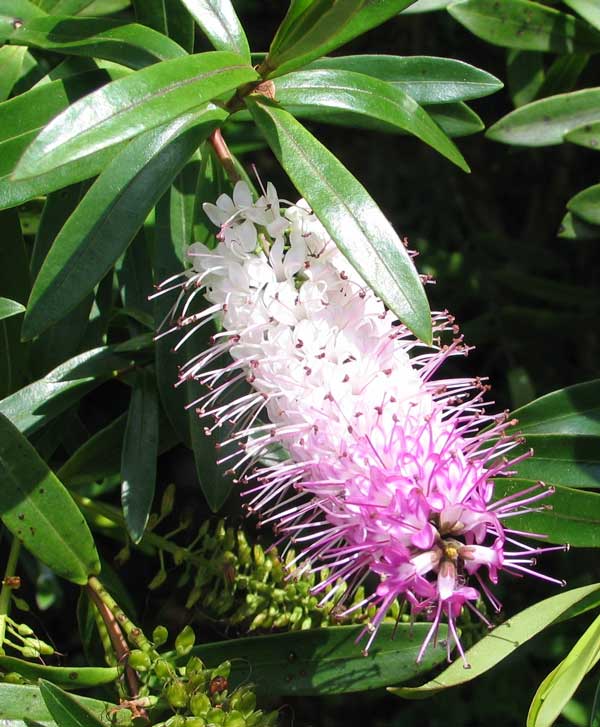
Veronica speciosa (*)
Classification System: APG IV
Superregnum: Eukaryota
Regnum: Plantae
Cladus: Angiosperms
Cladus: Eudicots
Cladus: Core eudicots
Cladus: Asterids
Cladus: Lamiids
Ordo: Lamiales
Familia: Plantaginaceae
Tribus: Veroniceae
Genus: Veronica
Subgenus: Veronica subg. Pseudoveronica
Species: Veronica speciosa
Name
Veronica speciosa R.Cunn. ex A.Cunn., 1836
LECTOTYPE (designated by Moore in Allan, 1961: ): '.'
Synonymy
Hebe speciosa (A.Cunn.) Andersen, 1926: 693
References
Armstrong, T.T.J.; de Lange, P.J. 2005: Conservation genetics of Hebe speciosa (Plantaginaceae) an endangered New Zealand shrub. Botanical journal of the Linnean Society, 149(2): 229–239. DOI: 10.1111/j.1095-8339.2005.00437.x Reference page.
Bayly, M.; Kellow, A. 2006: An illustrated guide to New Zealand hebes. Te Papa Press, Wellington. Reference page. [See p. 284]
de Lange, P.J. & Cameron, E.K. 1992. Conservation status of titirangi (Hebe speciosa) New Zealand Botanical Society Newsletter 29: 11–15. PDF (full issue ) Reference page.
Hebe speciosa is a species of flowering plant in the plantain family known by the common names New Zealand hebe, showy hebe, showy-speedwell, and the Maori names Titirangi and Napuka. It is native to New Zealand but it can be found in other parts of the world where it is grown as an ornamental for its showy flowers.
Description
Full view of plant
This hebe is a shrub reaching heights between one and two meters. Its evergreen leaves are dark green, shiny, and quite thick, usually measuring 2 to 5 centimeters long. The inflorescence is up to 8 centimeters long and densely packed with pale pink to bright magenta flowers. Each flower is just under a centimeter wide and has a short throat spreading into a four-lobed corolla. Two very long stamens protrude from the throat of each flower, giving the inflorescence a whiskery look. The fruit is a capsule containing flat, smooth seeds.
In cultivation
Hebe speciosa, its many cultivars and hybrids are very popular garden plants in area with suitably mild temperate climates. Many can even be grown outdoors in sheltered parts of southern Britain. They appeal because of their lush evergreen foliage, showy flowerheads, long blooming season and ease of cultivation.
Popular cultivars include the purple-flowered 'Alicia Amherst' and deep pink 'Simon Deleaux'. Hybrids includes cultivars of Hebe × andersonii (Hebe salicifolia × Hebe speciosa), especially the variegated 'Andersonii'; and Hebe × franciscana (Hebe elliptica × Hebe speciosa) cultivars such as 'Blue Gem' and 'Waireka'.
As of December 2013, the New Zealand Landcare Research considers that all forms of Hebe and Parahebe should be returned to the genus in which they were originally classified: Veronica. This appeared to be gaining general acceptance but recent research is indicating that divisions such as Hebe, Parahebe, Chionohebe, Leonohebe and Derwentia should be retained.
Flammability & building protection
Hebe speciosa is included in the Tasmanian Fire Service's list of low flammability plants, indicating that it is suitable for growing within a building protection zone.[1]
References
Chladil and Sheridan, Mark and Jennifer. "Fire retardant garden plants for the urban fringe and rural areas" (PDF). www.fire.tas.gov.au. Tasmanian Fire Research Fund.
Retrieved from "http://en.wikipedia.org/"
All text is available under the terms of the GNU Free Documentation License

